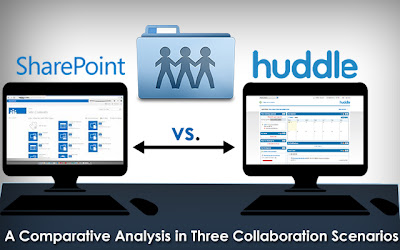Most
enterprises, nowadays, complete projects through distributed teams. So
businesses often look for customized content management and enterprise
collaboration to enable the members of a distributed team to communicate
and stay connected without any interruption. As innovative
collaboration software, Microsoft SharePoint is used by many companies
to organize data, people and projects. Microsoft has further released
SharePoint 2013 with a set of advanced features that enable a business
to stay connected with employees regardless of their physical location.
However,
each enterprise also has options to choose from several SharePoint
alternatives. In comparison to other content management and
collaboration systems, Huddle is more widely used by enterprises across
the world. In addition to allowing organizations to share files with
their team members and partners across the firewall, Huddle also
facilitates content collaboration through posting comments, assigning
tasks, and getting approvals. Also, an organization can create
individual user profiles to connect with each team member or partner
according to his role in the project.
Comparing Huddle and SharePoint in Three Common Usage Scenarios
1. Easy to Use and Deploy Collaboration Tools: Unlike
SharePoint, Huddle offers as set of administrative and collaboration
tools that are easy to learn and deploy. The tools further make it
easier for users to distribute site administration tasks among team
members without increasing the collaborative platform management
overheads. On the other hand, the use of SharePoint requires enterprises
to increase the collaborative platform management overheads. Further,
SharePoint must be implemented in an exact and planned way to avail its
advantages.
But
Huddle comes with a well designed user interface that performs
seamlessly across multiple workspaces. The SharePoint security features
vary based on the way the platform is deployed by an organization. But
Huddle allows users to implement security at multiple levels including
application, data center, physical and network. So an organization can
share files and data among its employees in a more secure environment.
2. Options to Integrate Third-Party and Custom Applications: Most
enterprises, nowadays, use custom applications developed by third-party
vendors to optimize their business process. So an enterprise will
definitely expect the collaboration software to support these
applications. In comparison to Huddle, SharePoint is more effective in
integrating the third-party and custom-developed applications. In
addition to the administrative tools required for these third-party
application integration, Huddle further lacks the collaboration feature.
So
the enterprises using third-party applications have to opt for
SharePoint. Also, SharePoint offers some advantages as a web application
development platform. Each enterprise has option to choose from several
partners dealing in SharePoint web parts and applications. Also, a
company can hire developers to build custom SharePoint applications
according to its business process. However, the integration of
third-party application may have an adverse impact on SharePoint
security.
3. Availing the Advantages of Enterprise’s Existing Cloud Infrastructure: Many
reports have already highlighted the constant increase in the
popularity of Cloud computing. Many enterprises are also investing in
Cloud infrastructure to meet the latest trends in technology and user
demand. Huddle supports a multi-tenant cloud architecture that helps
enterprises in reducing the initial investment. Microsoft has further
made SharePoint 2013 ready for Cloud environments. But the SharePoint
Cloud administration can be complex depending on the configuration and
security of the site.
On
the other hand, Huddle comes with agile administration tools that are
effective in managing users and adopting Bring Your Own Cloud (BYOC).
The users also have option to use the Huddle Activity Stream to view the
files or information on each accessible workspace. The feature further
makes it easier for the members of a distributed team to access business
data regardless of their current location. However, an organization
needs to deploy SharePoint in a planned and exact way to avail the
advantages of its existing Cloud infrastructure.
While
comparing SharePoint and Huddle, one must keep certain key points in
mind. SharePoint is a complete platform, whereas Huddle is only an
application. So as a platform, SharePoint allows users to perform a
variety of activities. But Huddle can be used only by focusing on
specific scenarios. At the same time, it is also important to evaluate
the two according to the technological infrastructure of the
organization. Despite offering improved collaboration, Huddle still
requires users to create additional overheads, and thus carry more risk.
Custom sharepoint development teams can help you build projects within allocated budgets and time schedules.
We provide sharepoint webparts development services. If you would like to know what makes us expert sharepoint developers india, please contact us at Mindfire Solutions.
